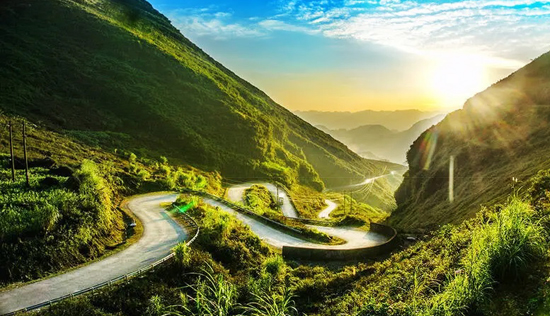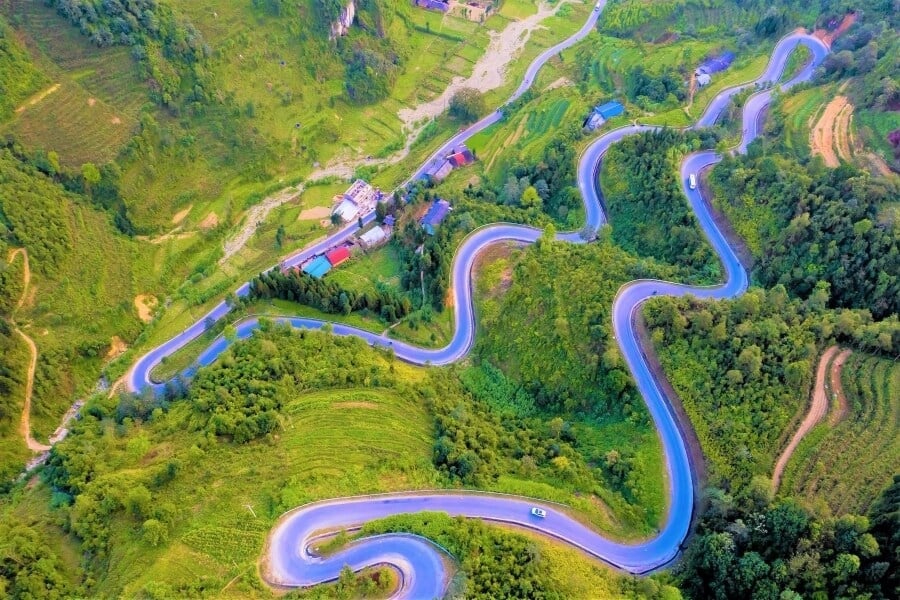Ha Giang
Ha Giang is a stunning province located in the northernmost part of Vietnam, known for its dramatic landscapes of towering mountains, winding roads, and lush valleys. The region is home to diverse ethnic communities, each with its unique traditions and culture. Ha Giang is famous for its breathtaking Dong Van Karst Plateau, a UNESCO Global Geopark, and its vibrant local markets. The province is a paradise for nature lovers and adventure seekers, offering scenic trekking routes, ethnic villages, and spectacular views of terraced rice fields.

Best Time to Visit
The best time to visit Ha Giang is from September to November and March to May, when the weather is cool and pleasant, ideal for trekking and exploring the stunning landscapes. During September to November, the region is filled with golden rice terraces, while March to May offers beautiful blooming peach and plum flowers. The temperatures are comfortable, ranging from 15°C to 25°C, making it perfect for outdoor activities and sightseeing. The rainy season, from June to August, brings heavy rain, which may make roads and trekking trails challenging, but it also enhances the beauty of the lush green landscapes.
Must-See Attractions
-
Dong Van Karst Plateau – A UNESCO Global Geopark, this vast plateau is famous for its stunning limestone mountains, deep valleys, and picturesque landscapes. It's a must-visit for those who enjoy breathtaking natural beauty.
-
Ma Pi Leng Pass – One of the most famous and scenic mountain passes in Vietnam, offering stunning views of the Nho Que River and the surrounding mountains.
-
Lung Cu Flag Tower – Located at the northernmost point of Vietnam, this flag tower offers panoramic views of the surrounding mountains and border with China.
-
Quan Ba Twin Mountains – Known for its unique "Fairy Bosom" shape, this site features two picturesque peaks and beautiful valleys.
-
H’mong King's Palace (Palace of the H'mong Family) – A historic building showcasing the cultural heritage of the H'mong ethnic group, offering insight into local architecture and traditions.
-
Phu Linh Village – A traditional H'mong village where you can experience local culture, architecture, and the peaceful rural lifestyle.
These attractions showcase the unique cultural, historical, and natural beauty that make Ha Giang a fascinating destination in northern Vietnam.

Culinary Delights
Ha Giang offers a variety of delicious dishes that reflect the region’s rich ethnic diversity and mountainous terrain. Some must-try foods include:
-
Thang Co (Horse Meat Stew) – A traditional dish of the H'mong people, made with horse meat, vegetables, and herbs, slow-cooked in a rich broth.
-
Banh Cuon (Steamed Rice Rolls) – Thin rice rolls filled with ground pork, herbs, and mushrooms, often served with fish sauce and crispy fried shallots.
-
Com Lam (Bamboo Rice) – Sticky rice cooked inside bamboo tubes, often served with grilled meats or wild vegetables, a traditional dish of the Tày people.
-
Xoi Ngu Sac (Five-Colored Sticky Rice) – A colorful rice dish made with natural food coloring from local plants, often served during festivals or special occasions.
-
Lap Xuong (Vietnamese Sausages) – A local specialty made with minced pork, herbs, and spices, typically grilled or dried, enjoyed as a snack or side dish.
-
Men men – A dish made from cornmeal, a staple food of the Tay people, often served with vegetables, meats, or stews.
The food of Ha Giang offers a unique taste of the region's cultural diversity, with fresh ingredients and hearty flavors perfect for the mountainous environment.


Where to stay
Ha Giang offers a range of accommodations, from cozy guesthouses to scenic eco-lodges, providing a comfortable stay amidst its breathtaking natural landscapes:
-
Luxury & Boutique Hotels: For a more comfortable stay, consider Ha Giang Riverside Lodge or Ha Giang Star Hotel, offering modern amenities and beautiful views of the surrounding mountains and valleys.
-
Eco-lodges & Homestays: For a more authentic experience, opt for Eco Home Homestay or Lung Cu Homestay, where you can stay with local families, experience traditional life, and enjoy the serene environment.
-
Mid-range Hotels: Hoang Su Phi Resort or Cuong Cuong Hotel provide a balance of comfort and affordability, perfect for travelers who want good service without breaking the bank.
-
Budget Guesthouses: For budget-friendly options, there are many simple guesthouses in Ha Giang City or near Dong Van like Hoa Cuong Guesthouse or Bui's Homestay, offering basic amenities and affordable rates.
Whether you prefer luxury, local culture, or a budget stay, Ha Giang has accommodations to suit every traveler.

Getting There
Ha Giang is located in northern Vietnam and can be accessed by car, bus, and motorbike from major cities like Hanoi:
- By Car: From Hanoi, it takes about 6–7 hours to drive to Ha Giang via National Highway 2. The road is well-maintained, but expect some winding paths as you get closer to the mountains.
- By Bus: Several buses depart daily from Hanoi’s My Dinh Bus Station or Gia Lam Bus Station to Ha Giang. The journey takes around 6–7 hours, and buses are an affordable and convenient option for travelers.
- By Train: There is no direct train to Ha Giang, but you can take a train to Lao Cai or Tuyen Quang and continue by bus or car to Ha Giang.
- By Motorbike: For adventurous travelers, renting a motorbike in Hanoi and driving to Hà Giang is a popular option, offering the flexibility to explore the scenic landscape along the way.
Once in Ha Giang, local taxis, motorbike taxis, and buses are available to take you to various attractions like Dong Van, Meo Vac, and Lung Cu.

